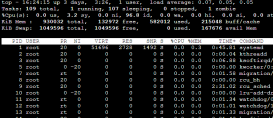定时器Timer应用场景非常广泛,在Linux下,有以下几种方法:
1,使用sleep()和usleep()
其中sleep精度是1秒,usleep精度是1微妙,具体代码就不写了。使用这种方法缺点比较明显,在Linux系统中,sleep类函数不能保证精度,尤其在系统负载比较大时,sleep一般都会有超时现象。
2,使用信号量SIGALRM + alarm()
这种方式的精度能达到1秒,其中利用了*nix系统的信号量机制,首先注册信号量SIGALRM处理函数,调用alarm(),设置定时长度,代码如下:
|
1
2
3
4
5
6
7
8
9
10
11
12
13
14
15
16
17
18
19
20
21
22
23
24
|
#include <stdio.h>#include <signal.h>void timer(int sig){ if(SIGALRM == sig) { printf("timer\n"); alarm(1); //we contimue set the timer } return ;}int main(){ signal(SIGALRM, timer); //relate the signal and function alarm(1); //trigger the timer getchar(); return 0;} |
alarm方式虽然很好,但是无法首先低于1秒的精度。
3,使用RTC机制
RTC机制利用系统硬件提供的Real Time Clock机制,通过读取RTC硬件/dev/rtc,通过ioctl()设置RTC频率,代码如下:
|
1
2
3
4
5
6
7
8
9
10
11
12
13
14
15
16
17
18
19
20
21
22
23
24
25
26
27
28
29
30
31
32
33
34
35
36
37
38
39
40
41
42
43
44
45
46
47
48
49
50
51
52
53
54
55
|
#include <stdio.h>#include <linux/rtc.h>#include <sys/ioctl.h>#include <sys/time.h>#include <sys/types.h>#include <fcntl.h>#include <unistd.h>#include <errno.h>#include <stdlib.h>int main(int argc, char* argv[]){ unsigned long i = 0; unsigned long data = 0; int retval = 0; int fd = open ("/dev/rtc", O_RDONLY); if(fd < 0) { perror("open"); exit(errno); } /*Set the freq as 4Hz*/ if(ioctl(fd, RTC_IRQP_SET, 1) < 0) { perror("ioctl(RTC_IRQP_SET)"); close(fd); exit(errno); } /* Enable periodic interrupts */ if(ioctl(fd, RTC_PIE_ON, 0) < 0) { perror("ioctl(RTC_PIE_ON)"); close(fd); exit(errno); } for(i = 0; i < 100; i++) { if(read(fd, &data, sizeof(unsigned long)) < 0) { perror("read"); close(fd); exit(errno); } printf("timer\n"); } /* Disable periodic interrupts */ ioctl(fd, RTC_PIE_OFF, 0); close(fd); return 0;} |
这种方式比较方便,利用了系统硬件提供的RTC,精度可调,而且非常高。
4,使用select()
这种方法在看APUE神书时候看到的,方法比较冷门,通过使用select(),来设置定时器;原理利用select()方法的第5个参数,第一个参数设置为0,三个文件描述符集都设置为NULL,第5个参数为时间结构体,代码如下:
|
1
2
3
4
5
6
7
8
9
10
11
12
13
14
15
16
17
18
19
20
21
22
23
24
25
26
27
28
|
#include <sys/time.h>#include <sys/select.h>#include <time.h>#include <stdio.h>/*seconds: the seconds; mseconds: the micro seconds*/void setTimer(int seconds, int mseconds){ struct timeval temp; temp.tv_sec = seconds; temp.tv_usec = mseconds; select(0, NULL, NULL, NULL, &temp); printf("timer\n"); return ;}int main(){ int i; for(i = 0 ; i < 100; i++) setTimer(1, 0); return 0;} |
这种方法精度能够达到微妙级别,网上有很多基于select()的多线程定时器,说明select()稳定性还是非常好。
总结:如果对系统要求比较低,可以考虑使用简单的sleep(),毕竟一行代码就能解决;如果系统对精度要求比较高,则可以考虑RTC机制和select()机制。
以上就是小编为大家带来的Linux下实现定时器Timer的几种方法总结全部内容了,希望大家多多支持服务器之家~














